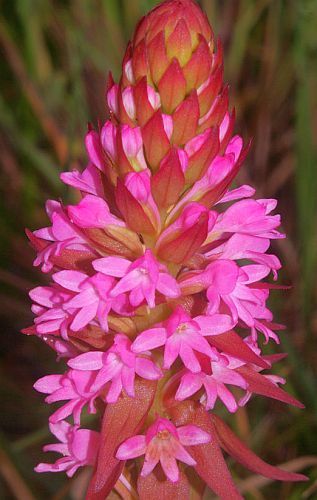Satyrium hallackii
Satyrium hallackii
Couldn't load pickup availability
The Satyrium hallackii, commonly known as Hallack's satyrium or pink satyr, is a terrestrial orchid prized for its fragrant pink or white flowers. This medium-to-large-sized, cool-growing orchid is native to Southern and South-Central Africa
- Flowers: The plant produces a dense inflorescence of flowers, each around 2 cm across. A defining feature of the Satyrium genus is its pair of horn-like spurs. The flowers of S. hallackii are non-resupinate, meaning they are not twisted upside-down. The flowers' color can range from pink to purple to white.
- Foliage: The plant has a leafy stem with sheathing leaves at the bottom and smaller, bract-like leaves toward the top.
- Roots: Like other Satyrium species, it is a tuberous geophyte that grows from underground tuber
- Range: S. hallackii has a wide native range, from Malawi to South Africa. It is found in the Cape Provinces, Eswatini, Free State, KwaZulu-Natal, Lesotho, Northern Provinces, and Zimbabwe.
- Preferred environment: It grows in moist, often grassy or marshy areas with well-drained soil. It can be found near coastlines in brackish soils or wetlands behind sand dunes, as well as in inland grasslands at elevations up to 2,200 meters
- Flowering season: Flowering occurs in the spring, which corresponds to November through January in the Southern Hemisphere.
- Pollinators: This orchid has diverse pollination systems, attracting bees, hawkmoths, and butterflies. Pollinators can differ between subspecies.
- Growth requirements: For cultivation, it requires a full to partial sun exposure and consistent watering during the growing season. The soil must be well-draining, as the plant cannot tolerate waterlogging
Price is for 5 seeds

Collapsible content
Fair Use Disclaimer
Our website may contain content not authorized for use by its owner but use of this material falls under the guidelines of fair use (They are for educational purposes only to show the plant only).
If you want to find our more or own any images displayed on our website and disagree with our assessment it constitutes 'fair use' please click here.

